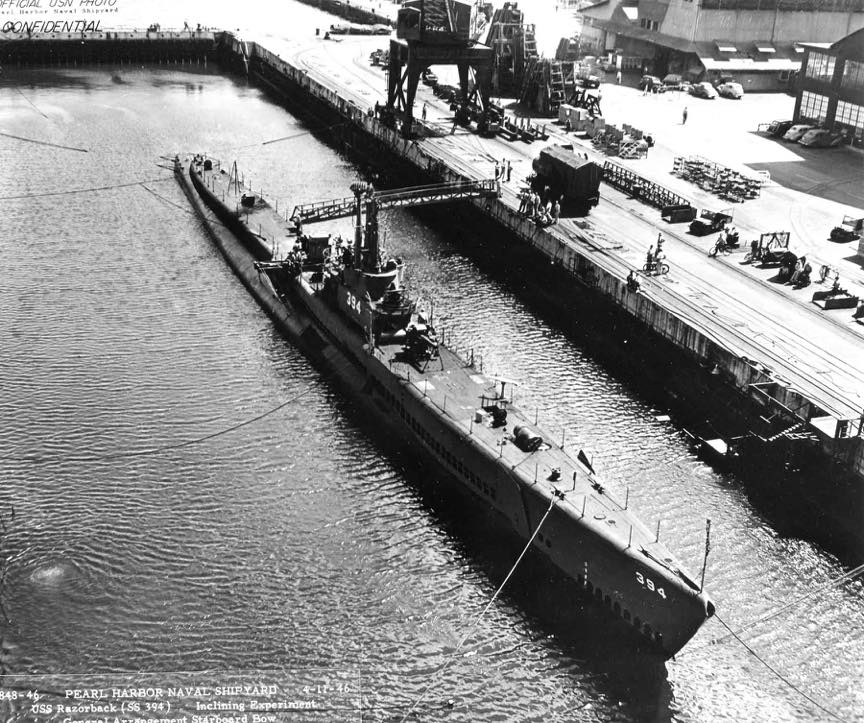Razorback SS-394

Razorback
(SS-394: dp. 1,525 (surf.), 2,415 (subm.) 1. 311'9", h. 27'3"dr. 15'5"; s. 20 k.; cpl. 81; a. 1 4", i 40mm., 2 20mm.,10 21" tt.; el. Balao)
Razorback (SS-394) was laid down by the Navy Yard, Portsmouth, N.H., 9 September 1943; launched 27 January 1944; sponsored by Mrs. H. F. D. Davis, and commissioned 3 April 1944, Lt. Comdr. A. M. Bontier in command.
After shakedown off New England, Razorback sailed to Pearl Harbor. Her first war patrol, commencing 25 August, was conduct.ed east of Luzon as a member of an offensive group in support of the mid-September Palau landings. After sighting only enemy antisubmarine planes, she headed northeastward, arriving at .NIidway 19 October.
On 15 November Razorback sailed from Miduay on her second war patrol in company with Trepang and Segundo Operating with these submarines in the Luzon Straits, Razorback damaged 6,933-ton freighter Kenjo Maru 6 December and sank 820-ton old destroyer Kuretake and damaged another freighter 30 December. She arrived at Guam for refit 5 January 1945.
On 1 February Razorback set out for the East China Sea for her third war patrol, this time accompanied by Segundo and Seacat. After sinking four wooden ships in three separate surface gun actions, she deposited three Japanese prisoners at Cuam before terminating her patrol at Pearl Harbor 26 March 1945.
On 7 May Razorback headed west again. Assigned to lifeguard duty in the Nanpo Shoto and Tokyo Bav areas, she rescued four B-29 pilots and a fighter pilot before retiring to Midway to end that patrol, and refit, 27 June.
On 22 July Razorback departed Midway for patrol in the Okhotsk Sea, where she sank six wooden cargo sea trucks and damaged two in a surface gun action. The remainder of the patrol was spent performing lifeguard services off J'aramushiro for Alaska based planes. On 31 August Razorback entered Tokyo Harbor with 11 other submarines to take part in the formal surrender of Japan. She departed 3 Septemher, arrived at Pearl Harbor on the 11th and San Diego on the 20th.
After the war she remained active with the Pacific Fleet serving off Japan and China in early 1948 and again in late 1949. In August 1952 she decommissioned incident to eonversion to Guppy IIA-type submarine. She recommissioned in January 1954 and reported to Submarine Squadron 10 at New London, Conn., for shakedown and training.
Following shakedown Razorback was transferred to the west coast and on 24 May 1954 became a unit of Submarine Squadron 3, based at San Diego. The remainder of 1954 and 1955 were spent providing antisubmarine training services for local surface and air units. In 1956 her range of operations was extended north to Canada and on 24 June 1957 she got underway on her first extended Far East deployment since the forties. Regularly deployed to the 7th Fleet into the sixties Razorback sailed into the South China Sea On her 1965 deployment where she earned her first Vietnam Service Medal. She returned to San Diego 1 February 1966, but was in the western Pacific 29 December 1966-3 July 1967 and 6 August 1968-February 1969. During 1969 and until January 1970, she continued to operate on the west coast out of San Diego, Calif. Razorback's last deployment, again to the western Pacific, was from 30 January to 7 August 1970. Not long after her return to the west coast, she was decommissioned at Hunter's Point Naval Shipyard. Concurrent with her decommissioning on 30 November, Razorback was transferred to the Turkish Navy and recommissioned Murat Reis (S-336).
Razorback earned five battle stars for World War II service and four stars for Vietnam service.
